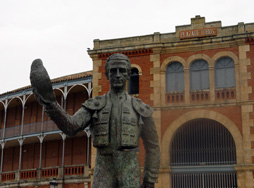|
It would be magnificent if the theatre made us shake the way that bullfights do. If it had known how to transport that aesthetic violence, it would be a beautiful play like the Illiad. A bullfight is a thing of beauty. --Ramón del Valle Inclán.
The Salamanca Bullfighting Museum was created with a clear purpose: to recognize and highlight the city’s bullfighting heritage and its matadors. It was created by the Federation of Bullfighting Clubs of Salamanca and it is currently managed by the Salamanca City Hall through its entity Tourism, Trade and Economic Development of Salamanca, S.A.U.
The Federation was created in 1989 with the mission of gathering all Salamancan bullfighters’ clubs (known as peñas) that existed in the province at the time. Among the founding clubs were the peñas "Paco Pallarés, "El Viti," “Peña Taurina Salmantina”, "Niño de la Capea", "Tendido Universitario," "Cesterito," "Víctor Manuel," "Tom´s Pallín," "Rui Bento Vázquez" and "Julio Robles".
During the Federation’s initial years, it was lead by José Silguero Honorato, a member of the peña "Paco Pallarés."
|
|
At the outset, there were various events and tributes, like the one to El Viti, where a statue was erected in his likeness at the entrance of Salamanca’s bullring La Glorieta.
|
|
 |
|
|
As the years passed, more clubs joined the Federation, such as the peñas "Pepe Luís Gallego," "José Ramón Martín," and "José Luis Ramos".
In 1991, Eusebio Cembellín Lorenzo, a member of the peña “El Niño de la Capea,” was unanimously elected as president. During this period, the governing board kindly named the late Julio Robles an honourary fellow. Simultaneously, the establishment of a new museum dedicated to Salamancan cattle ranches and matadors was set in motion.
In 1993 the Federation made it its mission to launch the bullfighting museum. As a first step, it created a commission that was responsible for compiling the addresses of bullfighters, ranchers and fans who donated different exhibition artefacts, be it due to their artistic or historical value.
|
|
|
|
After many long work days, the opening of the Salamanca Bullfighting Museum was held on December 29th, 1993 at a venue provided by the Salamanca City Hall on Doctor Piñuela Street in the city centre.
Throughout the following years, the museum continued to work on amassing new funds without neglecting other activities, such as hosting conferences, organizing festivities based on the Spanish bull, and award galas, all of which are aimed at disseminating the national festival, the corrida.
In 1995, the Federation changed the title of the Bullfighting Museum to the Salamanca "Primitivo Sánchez Laso" Bullfighting Museum. This was done in honour of the great fan who, for many years, was president of the Salamanca Bullfighting Club. Given that the museum was created by and for fans, this was considered a wonderful opportunity to honour him.
|
|
Eusebio Cembellín did not run for re-election in 2002. Instead, Felicísimo Mesonero Mesonero took his place and remained head of the governing board until 2007, the year that José Martín Hernández assumed leadership of the Federation.
Luciano Sánchez Hernández has been president of the Federation since 2016.
|
|
|
|
|
Among the current governing board’s objectives is modernizing and disseminating the Bullfighting Museum through efforts such as seasonal exhibitions. This came about with the creation of the “Travelling Museum,” whose goal is to spread the art of the corrida to every corner of the province.
On November 30, 2017, the mayor of Salamanca, Alfonso Fernández Mañueco, and the president of the Federation of Bullfighting Clubs, Luciano Sánchez, presented the new curation of the Bullfighting Museum.
The main aim is for the Museum to be a reference point in the city for disseminating, protecting and conducting cultural and heritage research on the world of the Spanish bull, its artists and the dehesa landscape. In addition, building knowledge about the reality of the bullfighting world, its diffusion and conservation, as well as understanding the values that are associated with its local identity are also important objectives.
Throughout its history, the Bullfighting Museum has become a reference point for all fans that desire to enjoy the art that the famed Cúchares, the celebrated XIX century matador, made his life. What is more, it has developed into a space that remembers great moments of glory from the world of the Spanish bull that will never disappear from the memory of its fans, the authors of a page written in gold ink in the book of Salamancan bullfighting.
|
|





